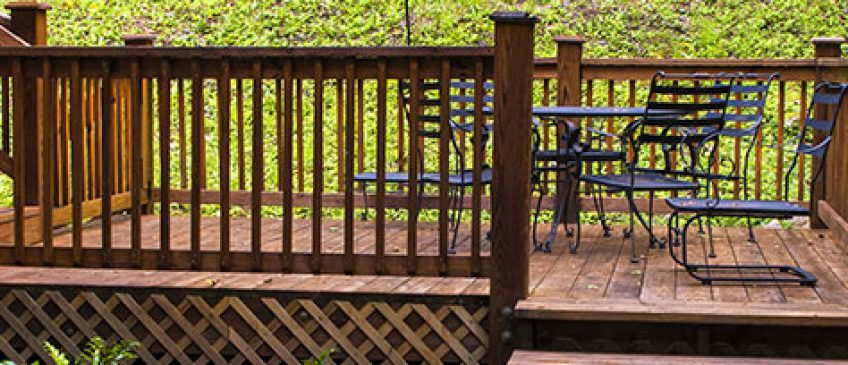With the summer season fast approaching, you should be thinking about your deck. A deck is one of the greatest components of your home because it gives you a place to spend time outside, entertain guests, barbeque, and thoroughly enjoy nice weather. If you live in an area with brutal winter weather, your deck, especially if it’s wooden has probably been damaged to some extent.
The majority of decks are comprised of treated lumber that has the ability to withstand harsh weather affects. However, wood decks can become damaged if they are not properly maintained. By properly caring for your deck before and after the winter season, you can prolong its lifespan and savor it for years to come.
Preventing Deck Damage
Preventing damage to wood decks should be a top priority for homeowners. Prevention is the best way to protect your deck and keep it in tip-top condition during every month of the year. Here are several suggestions on how to care for your deck and shield it from the snow and ice that may hinder it during the winter season:
Deck Cleaning
You should make it a regular ritual to clean your deck throughout the year in order to remove dirt, mold, mildew, dirt, and fungus. You can create your own deck cleaning solution by blending together 1 cup of dishwashing detergent, 1 quart of oxygen bleach, and 3 quarts of water and letting this mixture sit for about ten minutes.
When you remove debris and dirt from the surface of your deck as well as between the boards, you’ll be able to avoid structural damage and prepare it for better ventilation. This will minimize the load that your deck may be forced to carry. You should also remove furniture, garden pots, and planters from your deck and keep them stored away for during the colder months.
Avoid Over Shoveling
While it’s tempting to shovel piles of snow to save your deck from moisture, snow shoveling too often can actually do more harm than good to your deck. Since most decks are wood decks that are made of lumber, large quantities of snow do not pose a risk to high moisture. Snow shoveling should only be performed when the snow piles up higher than your deck rails or when you need to create an exit route from your back door.
In the event that you do need to shovel, you should always do so in a parallel rather than perpendicular path to the deck board. By shoveling perpendicularly, you can increase your risk of catching the edge of a board and prompting severe damage. Additionally, refrain from shoveling your deck with a metal blade as metal blades may gouge out sections of the plastic or wood. Ice chippers should also be avoided to reduce your chances of damaging the deck boards.
Apply a Deck Sealant
A quality water repellant deck sealant that coats your deck surface and fills in the cracks will give your deck ultimate protection in the winter. Start by purchasing a deck sealant online or at a local home improvement or hardware store. Next, spray down the deck with water to ensure that its surface is completely wet.
Then, wipe down the deck with a brush to clear any mold, leaves, or other materials that have collected on its surface. After the deck has been wiped down, rinse it again to remove any debris and let it sit for about a day until it’s completely dry. When the deck is dry, use a paint roller or mop to apply the deck sealer by following the directions listed on its label.
The entire deck should be covered with even strokes in one coat and left to dry for at least a day. While applying the deck sealant may be time consuming and require the removal of prior finishes, it is an easy and effective way to safeguard your deck from winter damages.
Cover with a Tarp
If the winters in your geographic area are known for extreme weather conditions, you may want to consider covering your deck with an insulating material or durable tarp to prevent winter water deterioration. A tarp can reduce the chances of ice formation and moisture making its way into the cracks of your deck.
Preparing Your Deck for the Summer Months
Unfortunately, sometimes winter deck damage prevention tactics do not work and your deck may end up damaged. To prepare your deck for the summer months, you can fix some damages such as graying from a lack of sealant or popped nails on your own while more extensive damages like pest infestations or rotted boards will require professional support.
The average homeowner will spend anywhere from $700 to $3,000 to repair winter deck damage. Moisture rot and termite damage are especially costly because they usually spread over a larger area of the deck and may require foundation repair.
While all decks are susceptible to winter destruction, wood decks generally require extra caution. To reduce your risk of having to deal with the expensive repairs and headaches that come with winter deck damage, cleaning your deck, being mindful of when you shovel, applying a deck sealant, and covering your deck with a strong tarp should all be done before the winter hits.

